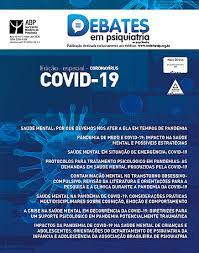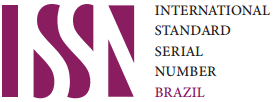Contaminação mental no transtorno obsessivo-compulsivo: revisão da literatura e orientações para a pesquisa e a clínica durante a pandemia da Covid-19
DOI:
https://doi.org/10.25118/2236-918X-10-2-5Palavras-chave:
Transtorno obsessivo-compulsivo, contaminação mental, COVID-19Resumo
É possível se contaminar através do pensamento? Objetivamente não; subjetivamente, porém, não se pode dizer o mesmo. O construto “contaminação mental” ainda é muito pouco estudado e, principalmente, pouco difundido na literatura em língua portuguesa. Sendo assim, o objetivo deste artigo foi revisar os estudos que relacionaram a contaminação mental ao transtorno obsessivo-compulsivo (TOC) ao longo dos últimos 5 anos. A busca foi realizada através das bases de dados PubMed, MEDLINE e PsycINFO, e após a aplicação dos critérios de inclusão, seis estudos foram revisados integralmente. Com base na análise das amostras utilizadas, dos instrumentos adotados, dos resultados encontrados e das limitações informadas pelos autores de cada estudo, concluímos que: 1) poucos estudos contemplaram tanto uma população clínica como uma não clínica; 2) o Vancouver Obsessional Compulsive Inventory-Mental Contamination foi o instrumento mais utilizado para mensurar a contaminação mental; 3) a contaminação mental tem relação com outros fenômenos que também fazem parte do TOC (como a propensão ao nojo); e 4) os estudos apresentam, comumente, limitações relacionadas à amostra. Ao final, apresentamos os passos necessários para incentivar a pesquisa científica brasileira acerca da contaminaçãomental, bem como estratégias que os profissionais da saúde mental podem adotar para orientar pacientes com TOC, durante o período da pandemia, visando reduzir a suscetibilidade à contaminação mental.
Downloads
Métricas
Referências
Rachman S, Radomsky AS, Elliott CM, Zysk E. Mental contamination: the perpetrator effect. J Behav Ther Exp Psychiatry. 2012;43:587-93. https://doi.org/10.1016/j.jbtep.2011.08.002
Coughtrey AE, Shafran R, Lee M, Rachman SJ. It's the feeling inside my head: a qualitative analysis of mental contamination in obsessive-compulsive disorder. Behav Cogn Psychother. 2012;40:163-73. https://doi.org/10.1017/S1352465811000658
Radomsky AS, Coughtrey A, Shafran R, Rachman S. Abnormal and normal mental contamination. J Obsessive Compuls Relat Disord. 2018;17:46-51. https://doi.org/10.1016/j.jocrd.2017.08.011
Herba JK, Rachman S. Vulnerability to mental contamination. Behav Res Ther. 2007;45:2804-12. https://doi.org/10.1016/j.brat.2007.07.010
Skapinakis P, Politis S, Karampas A, Petrikis P, Mavreas V. Prevalence, comorbidity, quality of life and use of services of obsessive-compulsive disorder and subthreshold obsessive-compulsive symptoms in the general adult population of Greece. Int J Psychiatry Clin Pract. 2019;23:215-24. https://doi.org/10.1080/13651501.2019.1588327
Lilienfeld SO, Pydych AL, Lynn SJ, Latzman RD, Waldman ID. 50 differences that make a difference: a compendium of frequently confused term pairs in psychology. Front Educ. 2017;2:37. https://doi.org/10.3389/feduc.2017.00037
Coughtrey AE, Shafran R, Knibbs D, Rachman SJ. Mental contamination in obsessive-compulsive disorder. J Obsessive Compuls Relat Disord. 2012;1:244-50. https://doi.org/10.1016/j.jocrd.2012.07.006
Jacoby RJ, Blakey SM, Reuman L, Abramowitz JS. Mental contamination obsessions: an examination across the obsessive-compulsive symptom dimensions. J Obsessive Compuls Relat Disord. 2018;17:9-15. https://doi.org/10.1016/j.jocrd.2017.08.005
Rachman S. Fear of contamination. Behav Res Ther. 2004;42:1227-55. https://doi.org/10.1016/j.brat.2003.10.009
Blakey SM, Jacoby RJ. The polluted mind: understanding mental contamination as a transdiagnostic phenomenon. J Obsessive Compuls Relat Disord. 2018;17:1-2. https://doi.org/10.1016/j.jocrd.2017.08.008
Coughtrey A, Shafran R, Bennett S, Kothari R, Wade T. Mental contamination: relationship with psychopathology and transdiagnostic processes. J Obsessive Compuls Relat Disord. 2018;17:39-45. https://doi.org/10.1016/j.jocrd.2017.08.009
Badour CL, Feldner MT, Babson KA, Blumenthal H, Dutton CE. Disgust, mental contamination, and posttraumatic stress: unique relations following sexual versus non-sexual assault. J Anxiety Disord 2013;27:155-62. https://doi.org/10.1016/j.janxdis.2012.11.002
Brake CA, Jones AC, Wakefield JR, Badour CL. Mental contamination and trauma: understanding posttraumatic stress, risky behaviors, and helpseeking attitudes. J Obsessive Compuls Relat Disord. 2018;17:31-8. https://doi.org/10.1016/j.jocrd.2017.08.010
Fairbrother N, Rachman S. Feelings of mental pollution subsequent to sexual assault. Behav Res Ther. 2004;42:173-89. https://doi.org/10.1016/S0005-7967(03)00108-6
Coughtrey AE, Shafran R, Lee M, Rachman S. The treatment of mental contamination: a case series. Cogn Behav Pract. 2013;20:221-31. https://doi.org/10.1016/j.cbpra.2012.07.002
Melli G, Bulli F, Carraresi C, Taranti no F, Gelli S, Poli A. The diff erenti al relati onship between mental contaminati on and the core dimensions of contact contaminati on fear. J Anxiety Disord. 2017;45:9-16. https://doi.org/10.1016/j.janxdis.2016.11.005
Zysk E, Shafran R, Williams T. The origins of mental contaminati on. J Obsessive Compuls Relat Disord. 2018;17:3-8. https://doi.org/10.1016/j.jocrd.2017.08.007
Poli A, Melli G, Radomsky AS. Diff erent disgust domains specifi cally relate to mental and contact contaminati on fear in obsessive-compulsive disorder: Evidence from a path analyti c model in an Italian clinical sample. Behav Ther. 2019;50:380-94. https://doi.org/10.1016/j.beth.2018.07.006
Mathes BM, McDermott KA, Okey SA, Vazquez A, Harvey AM, Cougle JR. Mental contaminati on in obsessive-compulsive disorder: associati ons with contaminati on symptoms and treatment response. Behav Ther. 2019;50:15-24. https://doi.org/10.1016/j.beth.2018.03.005
Shafran R, Zysk E, Williams T. The origins of mental contaminati on. J Obsessive Compuls Relat Disord. 2018;17:38. https://doi.org/10.1016/j.jocrd.2017.08.007
Coughtrey AE, Shafran R, Rachman SJ. Imagery in mental contaminati on. Behav Cogn Psychother. 2015;43:257-69. https://doi.org/10.1017/S1352465813000957
Rachman S, Coughtrey A, Shafran R, Radomsky A. Oxford guide to the treatment of mental contaminati on. Oxford: Oxford University; 2014. https://doi.org/10.1093/med:psych/9780198727248.001.0001
Borsa JC, Damásio BF, Bandeira DR. Adaptação e validação de instrumentos psicológicos entre culturas: algumas considerações. Paidéia (Ribeirão Preto). 2012;22:423-32. https://doi.org/10.1590/S0103-863X2012000300014
Henrich J, Heine SJ, Norenzayan A. The weirdest people in the world? Behav Brain Sci. 2010;33:61-83. https://doi.org/10.1017/S0140525X0999152X
Klein JP, Moritz S. On the relevance of mental imagery beyond stress-related psychiatric disorders. Front Psychiatry. 2014;5:77. https://doi.org/10.3389/fpsyt.2014.00077
Krishna A, Cian L, Sokolova T. The power of sensory marketi ng in adverti sing. Curr Opin Psychol. 2016;10:142-7. https://doi.org/10.1016/j.copsyc.2016.01.007
Van Bavel JJ, Baicker K, Boggio PS, Capraro V, Cichocka A, Cikara M, et al. Using social and behavioural science to support COVID-19 pandemic response. Nat Hum Behav. 2020;4:460-71. https://doi.org/10.1038/s41562-020-0884-z
Petersen M. The unpleasant truth is the best protecti on against coronavirus [Internet]. 2020 Mar 9 [cited 2020 May 20]. http://www.pure.au.dk/portal/files/181464339/The_unpleasant_truth_is_the_best_protection_against_coronavirus_Michael_Bang_Petersen.pdf
Finset A, Bosworth H, Butow P, Gulbrandsen P, Hulsman RL, Pieterse AH, et al. Eff ecti ve health communicati on-a key factor in fi ghti ng the COVID-19 pandemic. Pati ent Educ Couns. 2020;103:873-6. https://doi.org/10.1016/j.pec.2020.03.027
Sorokowski P, Groyecka A, Kowal M, Sorokowska A, Białek M, Lebuda I, et al. Informati on about pandemic increases negati ve atti tudes toward foreign groups: a case of COVID-19 outbreak [Internet]. 2020 Mar https://doi.org/10.31234/osf.io/j23vt [cited 2020 May 20]. https://psyarxiv.com/j23vt/
Navarrete CD, Fessler DM. Disease avoidance and ethnocentrism: the eff ects of disease vulnerability and disgust sensiti vity on intergroup atti tudes. Evol Hum Behav. 2006;27:270-82. https://doi.org/10.1016/j.evolhumbehav.2005.12.001
Curti s V, de Barra M, Aunger R. Disgust as an adapti ve system for disease avoidance behaviour. Philos Trans R Soc Lond B Biol Sci. 2011;366:389-401. https://doi.org/10.1098/rstb.2010.0117
Silva AG, Miranda DM, Diaz AP, Teles AL, Malloy-Diniz LF, Palha AP. Mental health: why it sti ll matt ers in the midst of a pandemic. Braz J Psychiatry. 2020 Apr 3;S1516-44462020005008202. doi: 10.1590/1516-4446-2020-0009. Online ahead of print. https://doi.org/10.1590/1516-4446-2020-0009
Duan L, Zhu G. Psychological interventi ons for people aff ected by the COVID-19 epidemic. Lancet Psychiatry 2020;7:300-2. https://doi.org/10.1016/S2215-0366(20)30073-0
Correa H, Malloy-Diniz LF, da Silva AG. Why psychiatric treatment must not be neglected during the COVID-19 pandemic. Braz J Psychiatry. 2020 Apr 30;S1516-44462020005011204. https://doi.org/10.1590/1516-4446-2020-0995
Yao H, Chen JH, Xu YF. Pati ents with mental health disorders in the COVID-19 epidemic. Lancet Psychiatry. 2020;7:e21. https://doi.org/10.1016/S2215-0366(20)30090-0
Downloads
Publicado
Como Citar
Edição
Seção
Licença

Este trabalho está licenciado sob uma licença Creative Commons Attribution-NonCommercial 4.0 International License.
Debates em Psiquiatria permite que o (s) autor (es) mantenha(m) seus direitos autorais sem restrições. Atribuição-NãoComercial 4.0 Internacional (CC BY-NC 4.0) - Debates em Psiquiatria é regida pela licença CC-BY-NC
































